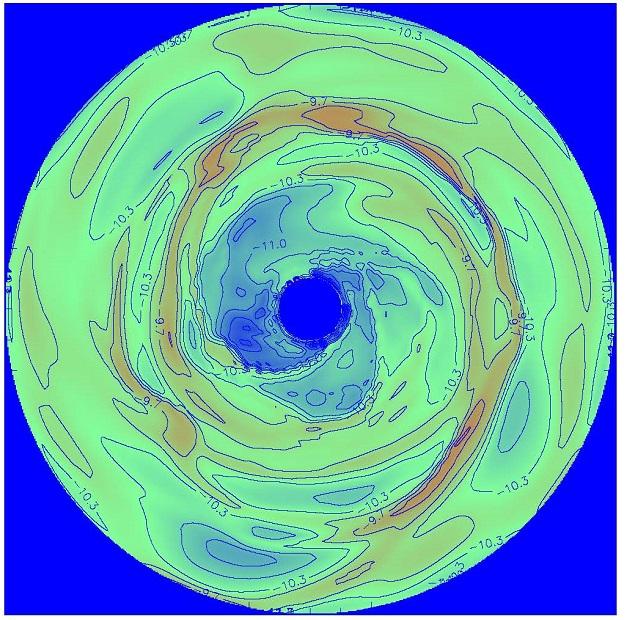Spiral arms cradle baby terrestrial planets

Boss' model disk after 205 years of evolution, courtesy of Alan Boss. Credit: Alan Boss
In the early stages of their formation, stars are surrounded by rotating disks of gas and dust. The dust grains in the disk collide and aggregate to form pebbles, which grow into boulders, and so on increasing in size through planetesimals, planetary embryos, and finally rocky terrestrial planets.
But there are some difficult outstanding questions raised by this theory. One of these is that the pressure gradient of the gas in the disk would create a headwind that would spiral the pebbles and boulders inward toward the young protostar, where they would be destroyed.
The problem is most acute in bodies that are between 1 and 10 meters in radius, because they would be most susceptible to the gas drag. If too many particles in this size range were lost, there wouldn't be enough remaining to collide with each other and accumulate into planetesimals and, eventually, planets.
Observations of young stars that are still surrounded by their gas disks demonstrate that those similar in size to our own Sun often undergo periodic explosive bursts, about 100 years in duration, during which the star's luminosity increases.
More importantly, these events can be linked to a period of gravitational instability in the disk. Boss's new work shows that such a phase can scatter the at-risk 1- to 10-meter bodies outward away from the developing star, rather than inward toward it.
Recent work has shown the presence of spiral arms around young stars, similar to those thought to be involved in the short-term disruptions in the disk. The gravitational forces of these spiral arms could scatter outward the problematic boulder-sized bodies, allowing them to accumulate rapidly to form planetesimals large enough that gas drag is no longer a problem.
Boss's modeling techniques hone in on the idea that spiral arms might be able to answer the question of how a developing solar system avoids losing too many larger bodies before the boulders have a chance to grow into something bigger.
“This work shows that boulder-sized particles could, indeed, be scattered around the disk by the formation of spiral arms and then avoid getting dragged into the protostar at the center of the developing system,” Boss explained. “Once these bodies are in the disk's outer regions, they are safe and able to grow into planetesimals.”
Smaller particles, however, ranging between 1 and 10 centimeters, are much more likely to be accreted back into the protostar and lost, regardless of spiral arm formation, Boss' models show.
“While not every developing protostar may experience this kind of short-term gravitational disruption phase, it is looking increasingly likely that they may be much more important for the early phases of terrestrial planet formation than we thought,” Boss added.
###
This work was partially supported by NASA.
The Carnegie Institution for Science is a private, nonprofit organization headquartered in Washington, D.C., with six research departments throughout the U.S. Since its founding in 1902, the Carnegie Institution has been a pioneering force in basic scientific research. Carnegie scientists are leaders in plant biology, developmental biology, astronomy, materials science, global ecology, and Earth and planetary science.
Media Contact
All latest news from the category: Physics and Astronomy
This area deals with the fundamental laws and building blocks of nature and how they interact, the properties and the behavior of matter, and research into space and time and their structures.
innovations-report provides in-depth reports and articles on subjects such as astrophysics, laser technologies, nuclear, quantum, particle and solid-state physics, nanotechnologies, planetary research and findings (Mars, Venus) and developments related to the Hubble Telescope.
Newest articles

NASA: Mystery of life’s handedness deepens
The mystery of why life uses molecules with specific orientations has deepened with a NASA-funded discovery that RNA — a key molecule thought to have potentially held the instructions for…

What are the effects of historic lithium mining on water quality?
Study reveals low levels of common contaminants but high levels of other elements in waters associated with an abandoned lithium mine. Lithium ore and mining waste from a historic lithium…

Quantum-inspired design boosts efficiency of heat-to-electricity conversion
Rice engineers take unconventional route to improving thermophotovoltaic systems. Researchers at Rice University have found a new way to improve a key element of thermophotovoltaic (TPV) systems, which convert heat…



